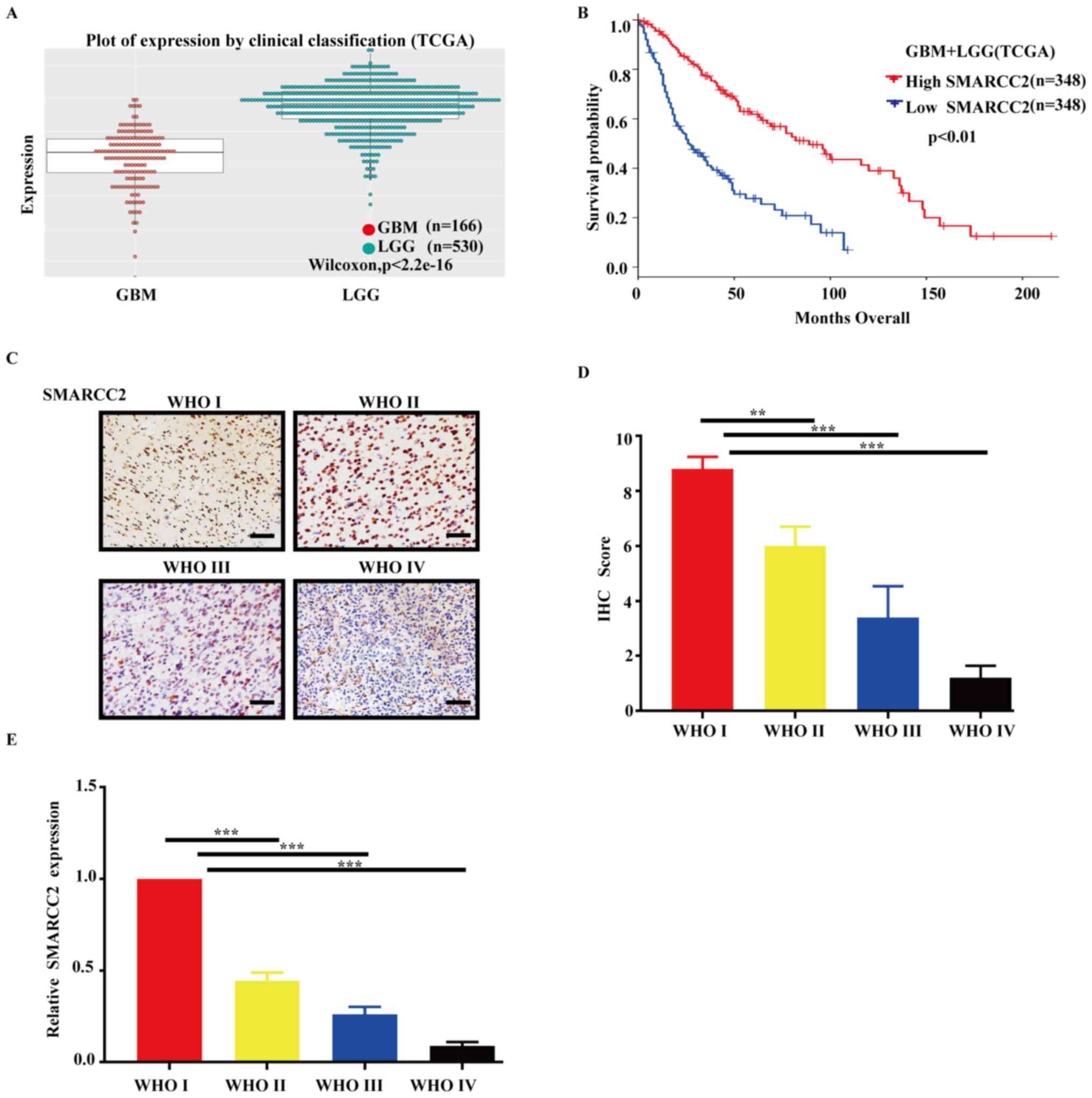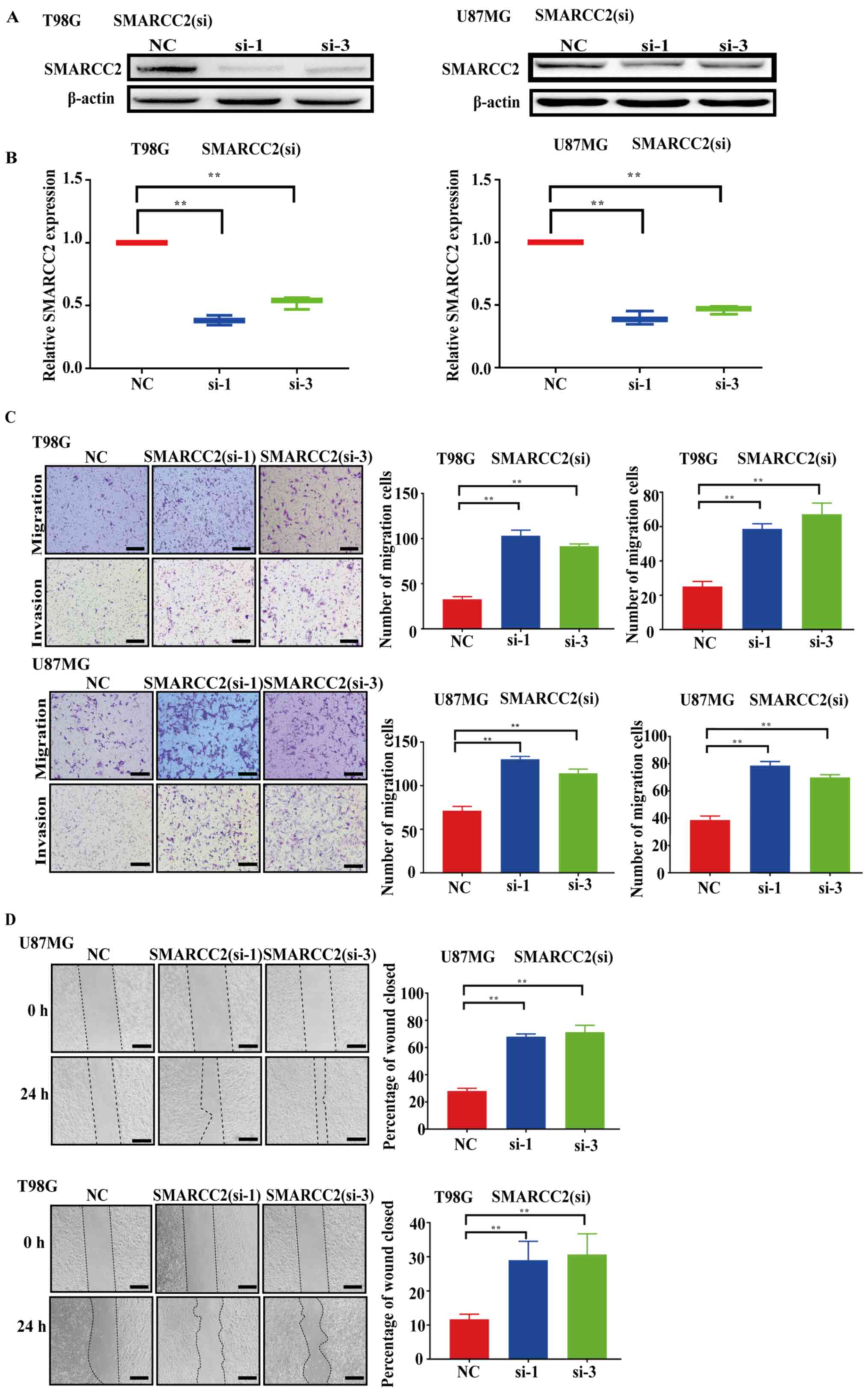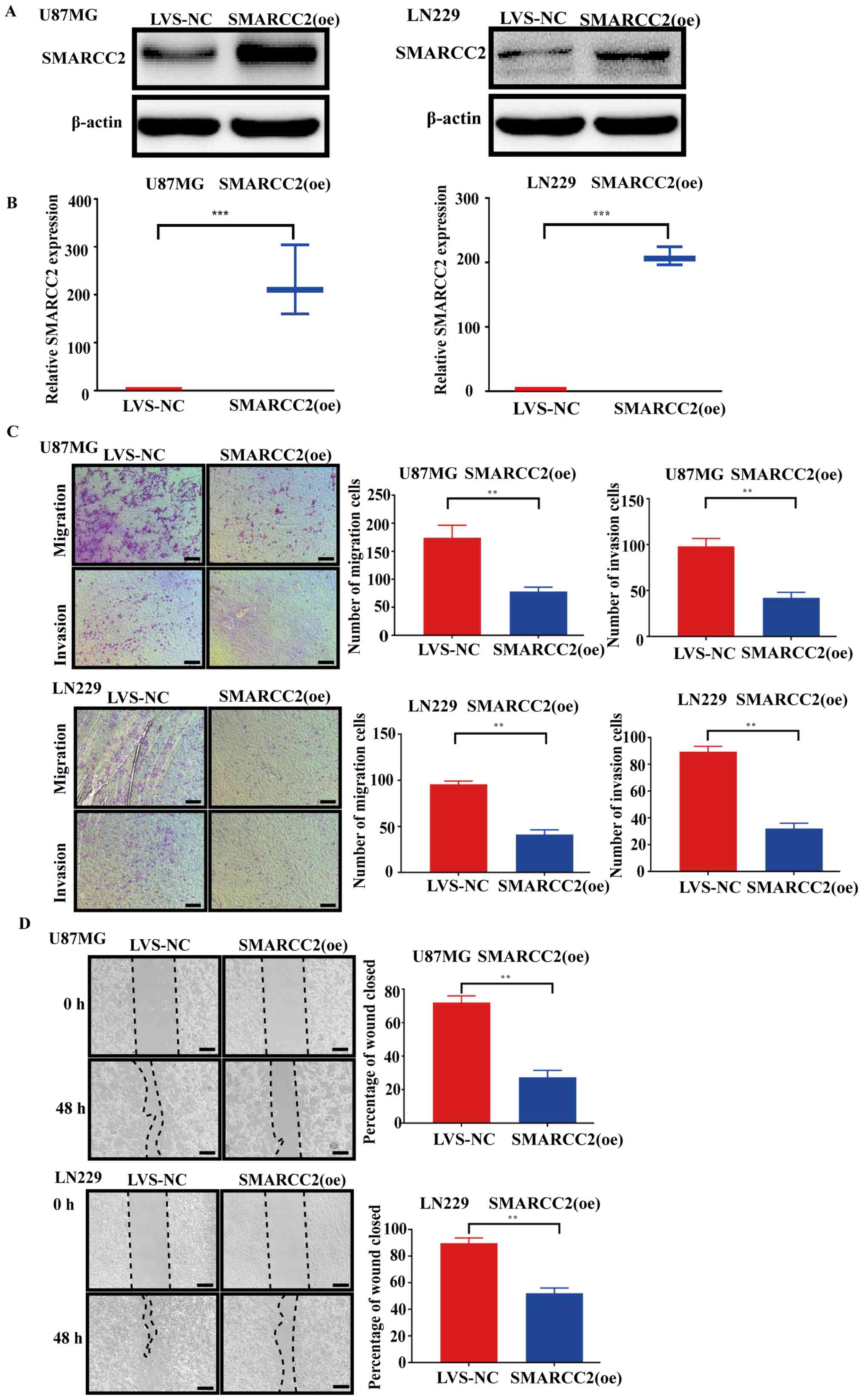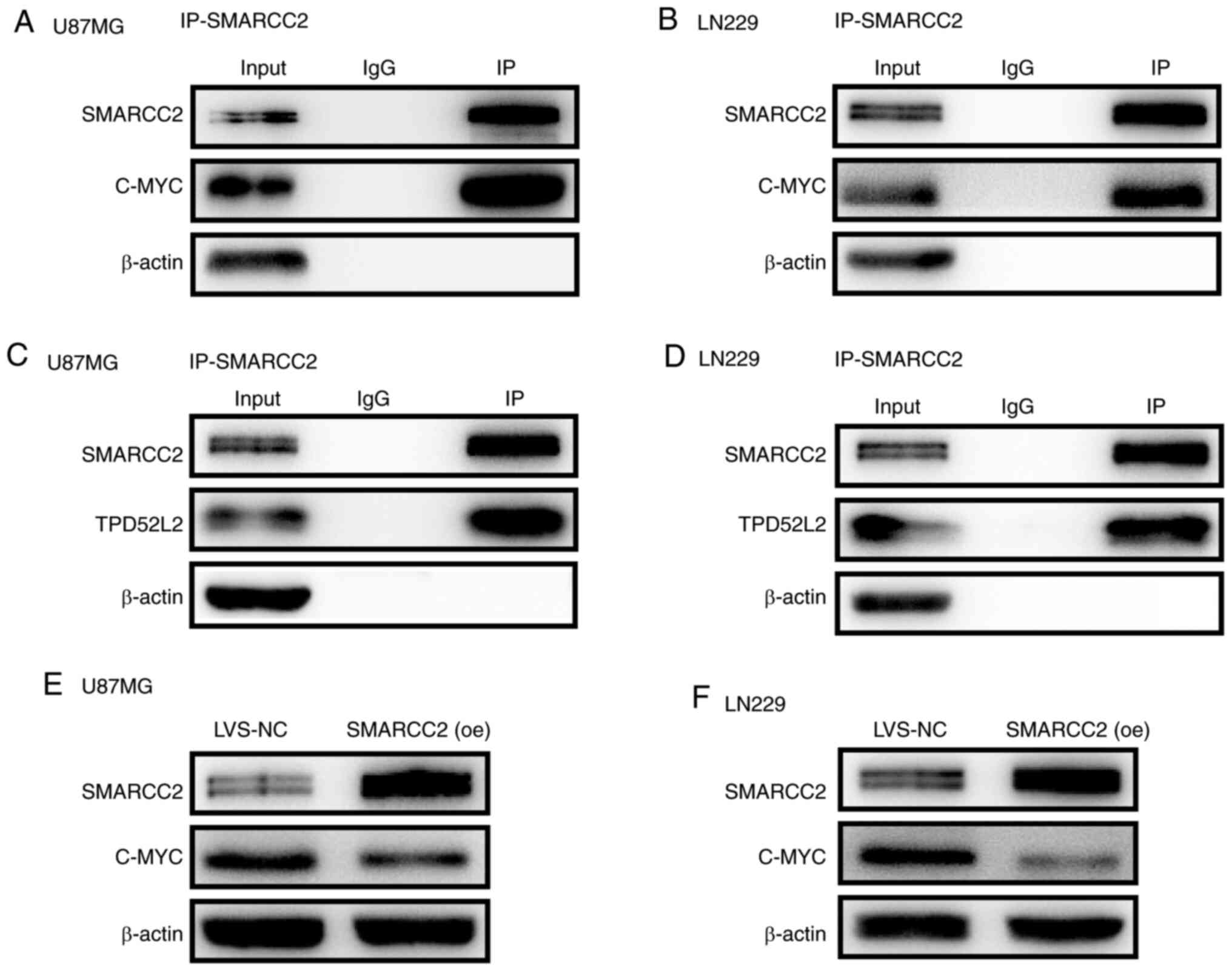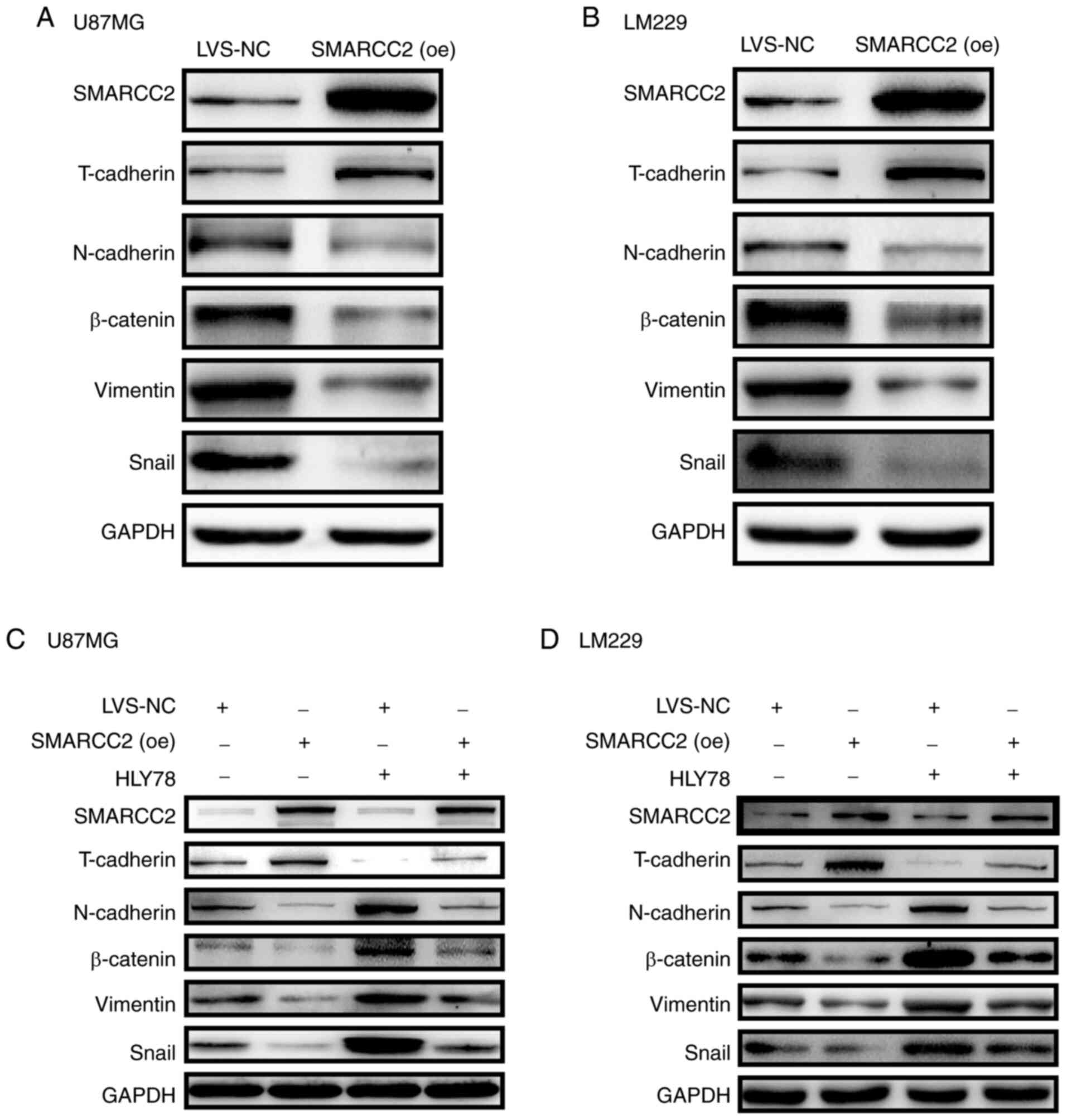|
1
|
Wilson BG and Roberts CW: SWI/SNF
nucleosome remodellers and cancer. Nat Rev Cancer. 11:481–492.
2011. View
Article : Google Scholar : PubMed/NCBI
|
|
2
|
He S, Wu Z, Tian Y, Yu Z, Yu J, Wang X, Li
J, Liu B and Xu Y: Structure of nucleosome-bound human BAF complex.
Science. 367:875–881. 2020. View Article : Google Scholar : PubMed/NCBI
|
|
3
|
Zhou Y, Johnson SL, Gamarra NI and
Narlikar GJ: Mechanisms of ATP dependent chromatin remodeling
motors. Annu Rev Biophys. 45:153–181. 2016. View Article : Google Scholar : PubMed/NCBI
|
|
4
|
Clapier R, Iwasa J, Cairns BR and Peterson
CL: Mechanisms of action and regulation of ATP-dependent
chromatin-remodelling complexes. Nat Rev Mol Cell Biol. 18:407–422.
2017. View Article : Google Scholar : PubMed/NCBI
|
|
5
|
Saha A, Wittmeyer J and Cairns BR:
Chromatin remodelling: The industrial revolution of DNA around
histones. Nat Rev Mol Cell Biol. 7:437–447. 2006. View Article : Google Scholar : PubMed/NCBI
|
|
6
|
Kassabov SR, Zhang B, Persinger J and
Bartholomew B: SWI/SNF unwraps, slides, and rewraps the nucleosome.
Mol Cell. 11:391–403. 2003. View Article : Google Scholar : PubMed/NCBI
|
|
7
|
Sati S and Cavalli G: Chromosome
conformation capture technologies and their impact in understanding
genome function. Chromosoma. 126:33–44. 2017. View Article : Google Scholar : PubMed/NCBI
|
|
8
|
Masliah-Planchon J, Bièche I,
Guinebretière JM, Bourdeaut F and Delattre O: SWI/SNF chromatin
remodeling and human malignancies. Ann Rev Pathol. 10:145–171.
2015. View Article : Google Scholar : PubMed/NCBI
|
|
9
|
Kadoch C, Hargreaves DC, Hodges C, Elias
L, Ho L, Ranish J and Crabtree GR: Proteomic and bioinformatic
analysis of mammalian SWI/SNF complexes identifies extensive roles
in human malignancy. Nat Genet. 45:592–601. 2013. View Article : Google Scholar : PubMed/NCBI
|
|
10
|
Almeida R, Fernández-Justel JM,
Santa-María C, Cadoret JC, Cano-Aroca L, Lombraña R, Herranz G,
Agresti A and Gómez M: Chromatin conformation regulates the
coordination between DNA replication and transcription. Nat Commun.
9:15902018. View Article : Google Scholar : PubMed/NCBI
|
|
11
|
Qiang Z, Jun-Jie L, Hai W, Hong L, Bing-Xi
L, Lei C, Wei X, Ya-Wei L, Huang A, Song-Tao Q and Yun-Tao L:
TPD52L2 impacts proliferation, invasiveness and apoptosis of
glioblastoma cells via modulation of wnt/β-catenin/snail signaling.
Carcinogenesis. 39:214–224. 2018. View Article : Google Scholar : PubMed/NCBI
|
|
12
|
Li H, Chen L, Qi S, Yu S, Weng Z, Hu Z,
Zhou Q, Xin Z, Shi L, Ma L, et al: HERC3-mediated SMAD7
ubiquitination degradation promotes autophagy-induced EMT and
chemoresistance in glioblastoma. Clin Cancer Res. 25:3602–3616.
2019. View Article : Google Scholar : PubMed/NCBI
|
|
13
|
Jackson CM, Choi J and Lim M: Mechanisms
of immunotherapy Resistance: Lessons from glioblastoma. Nat
Immunol. 20:1100–1109. 2019. View Article : Google Scholar : PubMed/NCBI
|
|
14
|
Tomiyama A and Ichimura K: Signal
transduction pathways and resistance to Targeted therapies in
glioma. Semin Cancer Biol. 58:118–129. 2019. View Article : Google Scholar : PubMed/NCBI
|
|
15
|
Tan MS, Sandanaraj E, Chong YK, Lim SW,
Koh LW, Ng WH, Tan NS, Tan P, Ang BT and Tang C: A STAT3-based gene
signature stratifies glioma patients for targeted therapy. Nat
Commun. 10:36012019. View Article : Google Scholar : PubMed/NCBI
|
|
16
|
Huang K, Liu X, Li Y, Wang Q, Zhou J, Wang
Y, Dong F, Yang C, Sun Z, Fang C, et al: Genome-Wide CRISPR-Cas9
screening identifies NF-κB/E2F6 responsible for EGFRvIII-associated
temozolomide resistance in glioblastoma. Adv Sci (Weinh).
6:19007822019. View Article : Google Scholar : PubMed/NCBI
|
|
17
|
Annibali D, Whitfield JR, Favuzzi E,
Jauset T, Serrano E, Cuartas I, Redondo-Campos S, Folch G,
Gonzàlez-Juncà A, Sodir NM, et al: Myc inhibition is effective
against glioma and reveals a role for Myc in profificient mitosis.
Nat Commun. 5:46322014. View Article : Google Scholar : PubMed/NCBI
|
|
18
|
Sang Y, Li Y, Zhang Y, Alvarez AA, Yu B,
Zhang W, Hu B, Cheng SY and Feng H: CDK5-dependent phosphorylation
and nuclear Translocation of TRIM59 promotes macroH2A1
ubiquitination and tumorigenicity. Nat Commun. 10:40132019.
View Article : Google Scholar : PubMed/NCBI
|
|
19
|
Weller M, Wick W, Aldape K, Brada M,
Berger M, Pfister SM, Nishikawa R, Rosenthal M, Wen PY, Stupp R and
Reifenberger G: Glioma. Nat Rev Dis Primers. 1:150172015.
View Article : Google Scholar : PubMed/NCBI
|
|
20
|
Livak KJ and Schmittgen TD: Analysis of
relative gene expression data using real-time quantitative PCR and
the 2(-Delta Delta C(T)) method. Method. 25:402–408. 2001.
View Article : Google Scholar : PubMed/NCBI
|
|
21
|
Yang M, Wang X, Jia J, Gao H, Chen P, Sha
X and Wu S: Tumor protein D52-like 2 contributes to proliferation
of breast cancer cells. Cancer Biother Radiopharm. 30:1–7. 2014.
View Article : Google Scholar : PubMed/NCBI
|
|
22
|
Zhang J, Cai H, Sun L, Zhan P, Chen M,
Zhang F, Ran Y and Wan J: LGR5, a novel functional glioma stem cell
marker, promotes EMT by activating the Wnt/β-catenin pathway and
predicts poor survival of glioma patients. J Exp Clin Cancer Res.
37:2252018. View Article : Google Scholar : PubMed/NCBI
|
|
23
|
Savas S and Skardasi G: The SWI/SNF
complex subunit genes: Their functions, variations, and links to
risk and survival outcomes in human cancers. Crit Rev Oncol
Hematol. 123:114–131. 2018. View Article : Google Scholar : PubMed/NCBI
|
|
24
|
Bögershausen N and Wollnik B: Mutational
landscapes and phenotypic spectrum of SWI/SNF-related intellectual
disability disorders. Front Mol Neurosci. 11:2522018. View Article : Google Scholar
|
|
25
|
Alver BH, Kim KH, Lu P, Wang X, Manchester
HE, Wang W, Haswell JR, Park PJ and Roberts CW: The SWI/SNF
chromatin remodelling complex is required for maintenance of
lineage specific enhancers. Nat Commun. 8:146482017. View Article : Google Scholar : PubMed/NCBI
|
|
26
|
Pillidge Z an Bray SJ, . SWI/SNF chromatin
remodeling controls Notch-responsive enhancer accessibility. EMBO
Rep. 20:e469442019.PubMed/NCBI
|
|
27
|
Wang W, Friedland SC, Guo B, O'Dell MR,
Alexander WB, Whitney-Miller CL, Agostini-Vulaj D, Huber AR, Myers
JR, Ashton JM, et al: ARID1A, a SWI/SNF subunit, is critical to
acinar cell homeostasis and regeneration and is a barrier to
transformation and epithelial-mesenchymal transition in the
pancreas. Gut. 68:1245–1258. 2019. View Article : Google Scholar : PubMed/NCBI
|
|
28
|
Wang X, Lee RS, Alver BH, Haswell JR, Wang
S, Mieczkowski J, Drier Y, Gillespie SM, Archer TC, Wu JN, et al:
SMARCB1-mediated SWI/SNF complex function is essential for enhancer
regulation. Nat Genet. 49:289–295. 2017. View Article : Google Scholar : PubMed/NCBI
|
|
29
|
Nagarajan S, Rao SV, Sutton J, Cheeseman
D, Dunn S, Papachristou EK, Prada JG, Couturier DL, Kumar S,
Kishore K, et al: ARID1A influences HDAC1/BRD4 activity, intrinsic
proliferative capacity and breast cancer treatment response. Nat
Genet. 52:187–197. 2020. View Article : Google Scholar : PubMed/NCBI
|
|
30
|
Helming KC, Wang X, Wilson BG, Vazquez F,
Haswell JR, Manchester HE, Kim Y, Kryukov GV, Ghandi M, Aguirre AJ,
et al: ARID1B is a specific vulnerability in ARID1A-mutant cancers.
Nat. Med. 20:251–254. 2014.PubMed/NCBI
|
|
31
|
Chang L, Azzolin L, Di Biagio D, Zanconato
F, Battilana G, Lucon Xiccato R, Aragona M, Giulitti S, Panciera T,
Gandin A, et al: The SWI/SNF complex is a mechanoregulated
inhibitor of YAP and TAZ. Nature. 563:265–269. 2018. View Article : Google Scholar : PubMed/NCBI
|
|
32
|
Ruijtenberg S and van den Heuvel S: G1/S
inhibitors and the SWI/SNF complex control cell-cycle exit during
muscle differentiation. Cell. 162:300–313. 2015. View Article : Google Scholar : PubMed/NCBI
|
|
33
|
Wang Q, Zhou Y, Rychahou P, Harris JW,
Zaytseva YY, Liu J, Wang C, Weiss HL, Liu C, Lee EY and Evers BM:
Deptor is a novel target of Wnt/β-Catenin/c-Myc and contributes to
colorectal cancer cell growth. Cancer Res. 78:3163–3175. 2018.
View Article : Google Scholar : PubMed/NCBI
|
|
34
|
Lissanu Deribe Y, Sun Y, Terranova C, Khan
F, Martinez-Ledesma J, Gay J, Gao G, Mullinax RA, Khor T, Feng N,
et al: Mutations in the SWI/SNF complex induce a targetable
dependence on oxidative phosphorylation in lung cancer. Nat Med.
24:1047–1057. 2018. View Article : Google Scholar : PubMed/NCBI
|
|
35
|
Tsurusaki Y, Okamoto N, Ohashi H, Kosho T,
Imai Y, Hibi-Ko Y, Kaname T, Naritomi K, Kawame H, Wakui K, et al:
Mutations affecting components of the SWI/SNF complex cause
Coffin-Siris syndrome. Nat Genet. 44:376–378. 2012. View Article : Google Scholar : PubMed/NCBI
|
|
36
|
Kim KH, Kim W, Howard TP, Vazquez F,
Tsherniak A, Wu JN, Wang W, Haswell JR, Walensky LD, Hahn WC, et
al: SWI/SNF-mutant cancers depend on catalytic and non-catalytic
activity of EZH2. Nat Med. 21:1491–1496. 2015. View Article : Google Scholar : PubMed/NCBI
|
|
37
|
Rogers HA, Sousa S, Salto C, Arenas E,
Coyle B and Grundy RG: WNT/β-catenin pathway activation in Myc
immortalised cerebellar progenitor cells inhibits neuronal
differentiation and generates tumours resembling medulloblastoma.
Br J Cancer. 107:1144–1452. 2012. View Article : Google Scholar : PubMed/NCBI
|
|
38
|
Patel R, Brzezinska EA, Repiscak P, Ahmad
I, Mui E, Gao M, Blomme A, Harle V, Tan EH, Malviya G, et al:
Activation of β-catenin cooperates with loss of pten to drive
ar-independent castration-resistant prostate cancer. Cancer Res.
80:576–590. 2020. View Article : Google Scholar : PubMed/NCBI
|
|
39
|
Yu J, Wu SW and Wu WP: A tumor-suppressive
microRNA, miRNA-485-5p, inhibits glioma cell proliferation and
invasion by down-regulating TPD52L2. Am J Transl Res. 9:3336–3344.
2017.PubMed/NCBI
|
|
40
|
Chen Q, Wang P, Fu Y, Liu X, Xu W, Wei J,
Gao W, Jiang K, Wu J and Miao Y: MicroRNA-217 inhibits cell
proliferation, invasion and migration by targeting Tpd52l2 in human
pancreatic adenocarcinoma. Oncol Rep. 38:3567–3573. 2017.PubMed/NCBI
|
|
41
|
Xu J, Wang W, Zhu Z, Wei Z, Yang D and Cai
Q: Tumor protein D52-like 2 accelerates gastric cancer cell
proliferation in vitro. Cancer Biother Radiopharm. 30:111–116.
2015. View Article : Google Scholar : PubMed/NCBI
|
|
42
|
Zhou J, Lin Y, Shi H, Huo K and Li Y:
hABCF3, a TPD52L2 interacting partner, enhances the proliferation
of human liver cancer cell lines in vitro. Mol Biol Rep.
40:5759–5767. 2013. View Article : Google Scholar : PubMed/NCBI
|















